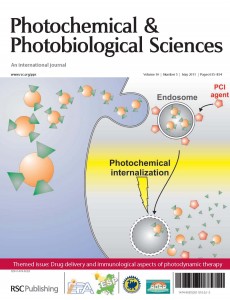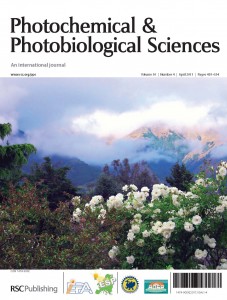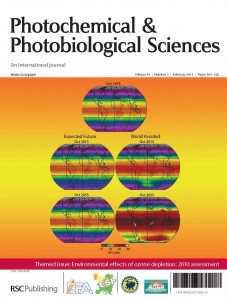As 2012 begins we take a look back to 2011 at three of the most highly accessed PPS articles. These highly downloaded articles from 2011 are free to access until March 1st 2012.
 The number one spot goes to an article from issue 5, the themed issue on photodynamic therapy. The paper, ‘Targeted photodynamic therapy of breast cancer cells using antibody–phthalocyanine–gold nanoparticle conjugates’, comes from a team including Dylan Edwards and David Russell at the University of East Anglia, UK. Their paper describes the development of a 4-component antibody–phthalocyanine–polyethylene glycol–gold nanoparticle conjugate which was stable, efficiently produced cytotoxic singlet oxygen and selectively targeted and destroyed breast cancer cells overexpressing the HER2 epidermal growth factor cell surface receptor. Read the full article here and the full issue here.
The number one spot goes to an article from issue 5, the themed issue on photodynamic therapy. The paper, ‘Targeted photodynamic therapy of breast cancer cells using antibody–phthalocyanine–gold nanoparticle conjugates’, comes from a team including Dylan Edwards and David Russell at the University of East Anglia, UK. Their paper describes the development of a 4-component antibody–phthalocyanine–polyethylene glycol–gold nanoparticle conjugate which was stable, efficiently produced cytotoxic singlet oxygen and selectively targeted and destroyed breast cancer cells overexpressing the HER2 epidermal growth factor cell surface receptor. Read the full article here and the full issue here.
 Second position goes to a paper from PPS issue 4 ‘Photoinduced formation of reversible dye radicals and their impact on super-resolution imaging’. Markus Sauer and co-workers from Germany demonstrate in this paper that upon irradiation with light of appropriate wavelength, standard organic dyes can be switched reversibly between a fluorescent and very stable non-fluorescent radical ion state with a lifetime of up to several hours. The high reliability of the photoswitching process permits super-resolution imaging with two laser lines. Read the full article here.
Second position goes to a paper from PPS issue 4 ‘Photoinduced formation of reversible dye radicals and their impact on super-resolution imaging’. Markus Sauer and co-workers from Germany demonstrate in this paper that upon irradiation with light of appropriate wavelength, standard organic dyes can be switched reversibly between a fluorescent and very stable non-fluorescent radical ion state with a lifetime of up to several hours. The high reliability of the photoswitching process permits super-resolution imaging with two laser lines. Read the full article here.
 The Montreal Protocol on Substances that Deplete the Ozone Layer is an international agreement on the protection of the stratospheric ozone layer, now ratified by 196 countries. Three Assessment Panels have continuously contributed information for facilitating informed decisions. PPS published, in February 2011, the full report from the Environmental Effects Assessment Panel (EEAP) which presents key findings on ‘environmental effects of ozone depletion and its interactions with climate change’ and is the first full Assessment since 2006. The article which was the third most downloaded in 2011 comes from this issue. This perspective article ‘Ozone depletion and climate change: impacts on UV radiation’ is an assessment of the effects of ozone depletion and climate change on past and future UV radiation received at Earth’s surface. It comes from a group of co-authors from New Zealand, South Africa, Greece, China, Sweden, Malaysia and the USA! Read the full article here and the full report here.
The Montreal Protocol on Substances that Deplete the Ozone Layer is an international agreement on the protection of the stratospheric ozone layer, now ratified by 196 countries. Three Assessment Panels have continuously contributed information for facilitating informed decisions. PPS published, in February 2011, the full report from the Environmental Effects Assessment Panel (EEAP) which presents key findings on ‘environmental effects of ozone depletion and its interactions with climate change’ and is the first full Assessment since 2006. The article which was the third most downloaded in 2011 comes from this issue. This perspective article ‘Ozone depletion and climate change: impacts on UV radiation’ is an assessment of the effects of ozone depletion and climate change on past and future UV radiation received at Earth’s surface. It comes from a group of co-authors from New Zealand, South Africa, Greece, China, Sweden, Malaysia and the USA! Read the full article here and the full report here.
To keep up to date with Photochemical and Photobiological Sciences sign up for e-alerts here.










